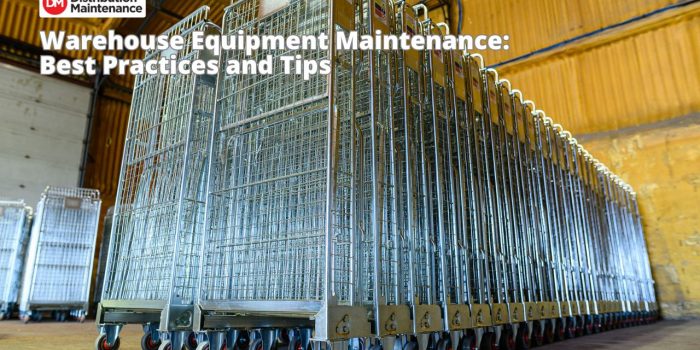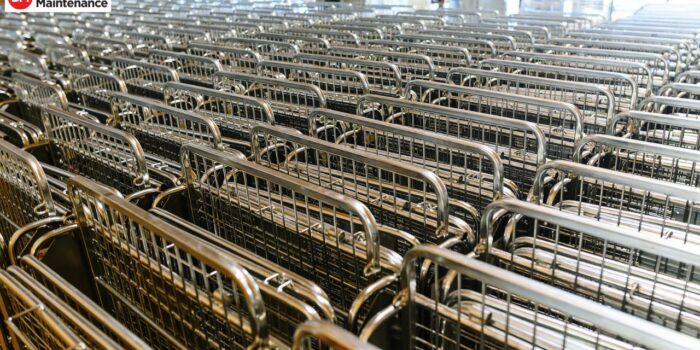Warehouse Equipment Maintenance: Best Practices and Tips
In the busy world of warehouses and logistics, equipment is crucial to keep things moving smoothly. Think of forklifts lifting heavy pallets, pallet trucks zipping around, and conveyor belts carrying goods – all this equipment is essential to get products where they need to go quickly and efficiently. But, just like your car needs regular oil changes, warehouse equipment needs care too. If you ignore maintenance, it can lead to expensive breakdowns, safety problems for your workers, and slowdowns that cost you time and money.
This blog will guide you through the best practices and essential tips for effective warehouse equipment maintenance, helping you keep your operations running smoothly and your equipment in top shape.
The Cost of Neglecting Maintenance
While it may seem tempting to postpone maintenance tasks until a problem arises, adopting a reactive approach to warehouse equipment upkeep can lead to a cascade of costly consequences that extend far beyond the immediate inconvenience of a breakdown.
The Domino Effect of Neglect
- Production Delays & Missed Deadlines: When a crucial piece of equipment unexpectedly fails, the entire workflow can grind to a halt. Orders pile up, shipments get delayed, and customers become frustrated. This not only impacts your bottom line but can also tarnish your reputation for reliability and efficiency.
- Skyrocketing Labour Costs: Equipment breakdowns often necessitate manual workarounds, forcing your employees to compensate for the machine’s shortcomings. This leads to increased labour costs as tasks take longer to complete, and productivity suffers.
- Unexpected & Costly Repairs: Ignoring minor issues or postponing maintenance can allow small problems to snowball into major breakdowns. These catastrophic failures often necessitate expensive repairs or even complete equipment replacements, putting a significant strain on your budget.
- Safety Risks & Potential Liabilities: Faulty equipment creates a hazardous work environment, putting your employees at risk of serious injuries. Accidents not only cause physical and emotional harm but can also lead to costly legal battles, increased insurance premiums, and a damaged company image.
- Erosion of Customer Trust & Satisfaction: Frequent equipment breakdowns can lead to delays in order fulfilment and inconsistent service, leaving customers feeling frustrated and dissatisfied. This can damage your reputation, erode customer loyalty, and lead to lost business opportunities.
The Power of Proactive Maintenance
In contrast, a proactive approach to maintenance can deliver a multitude of benefits that far outweigh the short-term savings of deferred upkeep.
- Reduced Downtime: Regular inspections and preventative maintenance help identify and address potential issues before they escalate, minimising unplanned downtime and ensuring smooth, uninterrupted operations.
- Extended Equipment Lifespan: Just like a well-maintained car, warehouse equipment that receives proper care and attention will last longer, delaying the need for costly replacements and maximising your return on investment.
- Lower Repair & Replacement Costs: Addressing minor issues early on can prevent major breakdowns, saving you money on expensive repairs or premature replacements.
- Enhanced Safety & Compliance: Well-maintained equipment operates more safely and reliably, reducing the risk of accidents and ensuring compliance with health and safety regulations. This protects your employees and your business from potential legal and financial repercussions.
- Improved Energy Efficiency & Cost Savings: Regular maintenance can enhance the energy efficiency of your equipment, reducing your carbon footprint and lowering your operating costs. This is not only good for the environment but also for your bottom line.
Establishing a Maintenance Programme
The cornerstone of effective warehouse equipment maintenance lies in establishing a well-structured and meticulously planned program. This strategic approach serves as a roadmap, guiding your maintenance efforts and ensuring that every piece of equipment receives the care it needs to function optimally.
Comprehensive Maintenance Plan: Begin by creating a detailed inventory of all the equipment in your warehouse. This includes everything from forklifts and pallet trucks to conveyors, racking systems, and even smaller tools and accessories. Once you have a comprehensive list, look into the specific maintenance requirements for each piece of equipment. Consult manufacturer recommendations, service manuals, and industry best practices to identify the recommended inspection intervals, preventative maintenance tasks, and potential wear points.
Based on this information, develop a schedule for regular inspections and preventative maintenance activities. Consider factors such as equipment usage, age, and criticality to your operations. Establish clear guidelines for reporting equipment issues. Ensure that any malfunctions or concerns are promptly communicated to the maintenance team. Assign responsibility for specific maintenance tasks to individuals or teams, fostering accountability and ensuring that nothing falls through the cracks.
Computerised Maintenance Management System (CMMS): In today’s digital age, leveraging technology can significantly enhance your maintenance program. Consider implementing a Computerised Maintenance Management System (CMMS) to streamline your efforts and unlock valuable insights. A CMMS acts as a centralised hub for all your maintenance information, automating scheduling and reminders, facilitating work order management, and tracking equipment history and performance.
With a CMMS, you can:
- Centralise Maintenance Information: Store all equipment manuals, service records, and maintenance histories in one easily accessible location.
- Automate Scheduling and Reminders: Set up automated reminders for inspections, preventative maintenance tasks, and equipment servicing, ensuring nothing is overlooked.
- Streamline Work Order Management: Create, assign, and track work orders efficiently, improving communication and collaboration between maintenance teams and other departments.
- Track Equipment History and Performance: Maintain a detailed record of each piece of equipment’s maintenance history, performance metrics, and repair costs. This information can help identify trends, predict future maintenance needs, and make informed decisions about equipment replacement.
- Generate Reports and Analytics: Leverage the power of data to gain valuable insights into your maintenance operations. Analyse equipment performance, identify areas for improvement, and make data-driven decisions to optimise your maintenance program.
Key Maintenance Practices
Effective warehouse equipment maintenance is not a one-size-fits-all proposition. It requires a proactive and multifaceted strategy that combines regular inspections, preventive measures, and swift response to emerging issues.
- Regular Inspections: Think of these as the “health checkups” for your equipment. Frequent visual inspections are essential to detect early signs of wear and tear, such as cracks, leaks, or loose components. Listen for unusual noises that could indicate underlying problems. Besides visual checks, functional inspections are crucial. Regularly test the equipment’s operation to ensure it’s performing as expected and identify any potential issues before they escalate into major breakdowns. And of course, never underestimate the power of cleanliness! Regular cleaning and lubrication, as per manufacturer recommendations, can significantly extend the lifespan of your equipment and prevent premature wear.
- Preventative Maintenance Tasks: This is where you shift from reactive to proactive. Schedule routine maintenance tasks, such as replacing worn parts before they fail, adjusting and calibrating equipment for optimal performance, and tightening bolts and fasteners to ensure structural integrity. Cleaning or replacing filters and vents can also improve efficiency and prevent overheating. By addressing minor issues early on, you can avoid costly repairs and unexpected downtime, ensuring your operations continue to run smoothly.
- Addressing Issues Promptly: When issues do arise, it’s crucial to respond quickly and decisively. Swift troubleshooting and accurate diagnosis are essential to minimise downtime and prevent further damage. Whether it’s a simple repair or a more complex replacement, taking action promptly can save you significant time and money in the long run.
- Training Your Workforce: Your employees are the frontline of your warehouse operations, so empowering them with knowledge and skills is key. Provide comprehensive training on proper equipment operation, including safe handling techniques and potential hazard awareness. Educate them on basic maintenance procedures, enabling them to identify and report potential issues early on. A well-trained workforce is not only more productive but also plays a vital role in ensuring the longevity and optimal performance of your valuable equipment.
By combining these key practices, you can create a robust maintenance strategy that protects your investment, enhances safety, and keeps your warehouse running at peak efficiency. Remember, proactive maintenance is not just an expense; it’s an investment in the long-term success of your business.
Additional Tips for Warehouse Equipment Maintenance
While regular inspections, preventative maintenance, and swift repairs form the backbone of an effective maintenance program, there are additional steps you can take to further enhance the lifespan and performance of your warehouse equipment.
- Maintain a Clean and Organised Warehouse: A clutter-free and well-organised warehouse is not just aesthetically pleasing, it’s also crucial for equipment longevity. Dust, debris, and other contaminants can infiltrate machinery, causing premature wear and tear, or even complete breakdowns. Regular cleaning and organisation help create a healthier environment for both your employees and your equipment.
- Prioritise Proper Storage: When equipment is not in active use, ensure it’s stored correctly in a clean, dry, and secure location. This protects it from the elements, prevents accidental damage, and ensures it’s ready for action when needed. Cover sensitive equipment, retract moving parts if possible, and follow any manufacturer-specific storage instructions.
- Invest in Quality from the Start: While it may be tempting to cut corners with cheaper equipment, investing in high-quality machinery from reputable suppliers pays off in the long run. Durable and reliable equipment is less prone to breakdowns and requires less frequent repairs, saving you money and minimising downtime.
- Nurture Strong Supplier Relationships: Building strong relationships with your equipment suppliers and service providers can be invaluable. They can offer expert advice, provide prompt support, and ensure you have access to genuine spare parts and timely repairs when needed.
- Continuous Improvement: The range of warehouse equipment is constantly evolving, with new technologies and best practices emerging regularly. Periodically review and update your maintenance procedures based on equipment performance, usage patterns, and industry trends. This ensures that your program remains effective and aligned with the latest advancements in warehouse equipment maintenance.
By incorporating these additional tips into your maintenance strategy, you can further enhance the lifespan, performance, and reliability of your warehouse equipment. Remember, proactive and comprehensive care is the key to maximising your investment and ensuring your warehouse operates at peak efficiency.
Your Partner in Warehouse Equipment Upkeep: Distribution Maintenance’s Expertise
Beyond offering best practices and guidance, Distribution Maintenance is your trusted partner for comprehensive warehouse equipment maintenance and repair services. Our skilled technicians and engineers have extensive experience in keeping your operations running smoothly. Here’s a glimpse into our key services:
- Roll Cage Repair & Maintenance: From minor fixes to major overhauls, we’re equipped to handle all your roll cage repair needs. Our on-site and off-site repair options ensure minimal disruption to your operations.
- Pallet Cage Repair & Maintenance: We specialise in keeping your pallet cages in top shape, extending their lifespan and maximising their efficiency.
- Thermotainer Repair & Maintenance: Ensure your temperature-sensitive products are safeguarded with our expert Thermotainer repair and maintenance services.
- Steel Fabrication & Custom Metal Works: We can fabricate or modify existing equipment to meet your specific needs, providing tailored solutions for unique challenges.
Our commitment to quality workmanship, prompt service, and competitive pricing makes us the ideal partner for all your warehouse equipment maintenance needs.
Conclusion
Effective warehouse equipment maintenance is essential for maximising productivity, minimising downtime, and ensuring a safe working environment. By establishing a robust maintenance program, implementing best practices, and partnering with a trusted service provider like Distribution Maintenance, you can keep your equipment running smoothly and support the long-term success of your business.
Remember, your equipment is an investment, and proactive maintenance is the key to protecting that investment and achieving your operational goals. Ready to optimise warehouse equipment maintenance? Contact Distribution Maintenance by our email info@distributionmaintenance.com or call us at 01279 883 286 today for expert advice, tailored solutions, and comprehensive repair and maintenance services. Let us help you keep your operations running smoothly and your business thriving!









